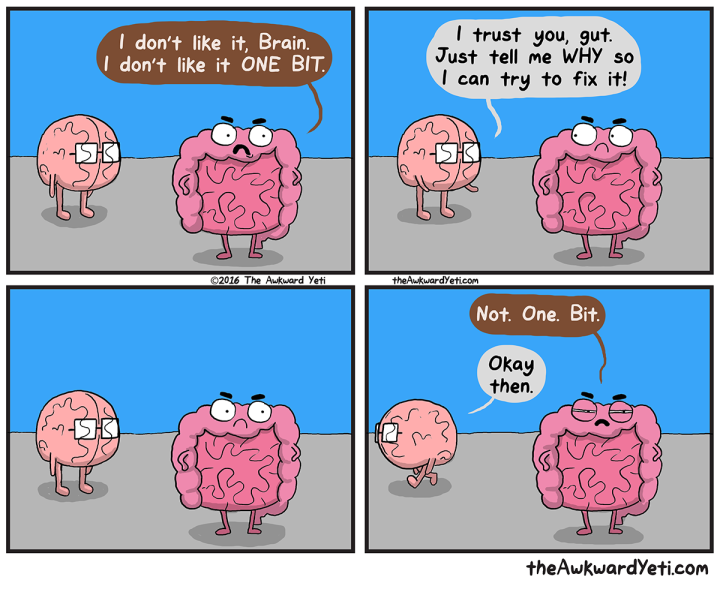Metabolites on my mind – molecular messengers in gut–brain communication

Most of us have come across the phrase “butterflies in my stomach”. It describes a physical sensation in the gut in response to an exciting or nerve-inducing situation. Although the sensation is subjective, the stomach twisting feeling is a common description for the moment preceding for example a public appearance. Another familiar saying might be “gut feeling”. It’s a physical reaction, yes, but also an action. Gut feeling or intuition is the fleeting feeling we can’t explain but it somehow feels quite right, nonetheless. In other words, the gut is trying to tell you something your consciousness has yet to process.
While the consciousness of the gut has been brilliantly portrayed in Nick Seluk’s comics, thoughts do not arise from the bowel. However, the gastrointestinal tract is equipped with a very capable self-sustaining enteric nervous system often referred to as the “second brain”.
Although it has been established centuries ago that emotions and mental status alter our gastrointestinal function, their two-way nature is a more recent concept. The dialogue between our higher and lower brains is maintained through several neurobiological pathways including but not limited to nerves, hormones and tiny molecules called metabolites.
As my research focuses on discovering promising candidate metabolites in the gut–brain dialogue, I will elaborate on a familiar metabolite: serotonin. Serotonin is best-known for its connections to mood and depression. However, serotonin has also been linked to appetite, memory and cognition, for instance. In fact, 95% of serotonin is produced within the gut and influenced by the gut bacteria residing in our large intestine. Moreover, gut bacteria can synthesize a wide range of molecules involved in our metabolism. Since gut bacteria feast on the leftovers, i.e. non-digestible fibers, of our food, our dietary choices have the potential to shape the composition of the intestinal microbial community and thus the output of their metabolites.
Characterizing and identifying metabolites is the core of our team’s work in the research field called metabolomics. It can be applied to any biological sample to inspect its chemical composition. In my work, I apply metabolomics techniques on human blood and fecal samples to uncover gut microbial metabolites that could influence our mood or cognition.
So far we’ve discovered that certain lipid and caffeine metabolites are associated with psychological symptoms in patients with alcohol use related problems. Our next effort is to characterize whether consuming additional fiber alters psychological symptoms or the metabolites associated with them. Meanwhile, ongoing investigations are also looking into the fine details behind these associations, i.e. plausible mechanistic pathways. All of this research is done under the multinational collaboration called Gut2Behave, aiming in the long run to improve the care of behavioral disorders.
With the spotlight on the gut microbiota, the coming years will show how large, or small, is the role of gut microbiota in our mood or behavior. Meanwhile, gut feeling is something to take seriously.
Hany Ahmed
The writer is a PhD researcher in the Doctoral Programme in Technology (Food Chemistry) and employs metabolomics in his daily work to discover biochemical links between nutrition, health and gut microbiota.
Image: The Awkward Yeti
